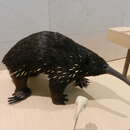Barton's or eastern long-nosed echidna (Zaglossus bartoni)
provided by EOL authors
The Barton's or eastern long-nosed echidna is widespread throughout the central mountains of New Guinea, the Foja Mountains (Indonesia) and the Huon Peninsula (Papua New Guinea). It has a very patchy distribution and is probably now extirpated from most of its range (specimens are very common in the fossil record). Historically, it has been recorded from sea level to around 4,150 m above sea level, but is rarely found at sea level now, but occurs mainly at 2,000-3,000 m (6,600-9,800 ft). It ranges from tropical hill forests to sub-alpine forests, grasslands and scrub and occurs in secondary habitats.
It differs from other long-nosed echidnas by having 5 claws on its fore feet and 4 on its hind feet. It is the largest monotreme and weighs 5-10 kg (11-22 lb). It is 60-100 cm (24-39 in) long and has no tail. It has dense black fur. It rolls into a spiny ball for defence. It can have large home ranges; one occupied 198 ha over two months. It feeds mainly on worms. The female lays eggs. A captive at London Zoo lived for 30 years. The echidna is listed as Critically Endangered and is on Appendix II of CITES, due to a suspected continuing population decline of at least 80% over the last three generations (45-50 years). Hunters say there have been declines in its area of occupancy and the species has been exploited due to hunting. It has been hunted to local extinction in densely populated and accessible regions of New Guinea, but may be more common in inaccessible areas. Tim Flannery says the subpopulations in the western half (mainly the central mountains of Papua, Indonesia) have largely gone extinct, but some in the east (Papua New Guinea) seem to be more secure. Populations are Decreasing. The echidna is heavily threatened by hunting for food by local people (a prime prey species) and by loss of habitat through conversion of suitable areas to cultivated land. A nickel mine has been proposed in the Wowo Gap area, which seems to support a good population of this species. The major populations are now largely confined to the higher reaches of the central massifs. The echidna has been recorded from some protected areas. There are four geographically isolated subspecies: Z. b. bartoni; Z. b. clunius; Z. b. smeenki and Z. b. diamondi. They differ mainly in body size.

